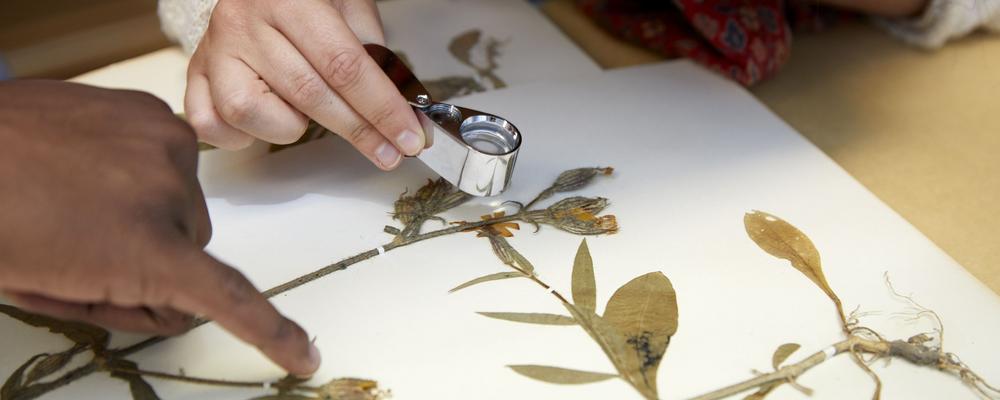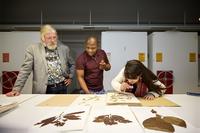
Herbarium GB
Herbarium GB is a common research infrastructure at the University of Gothenburg, located at the Department of Biological and Environmental Sciences. It has a large collection of dried plants, fungi, algae etc. for comparative and evolutionary studies.
The history of our herbarium dates back to late 18th century. At that time, the first collections formed a part of a “Naturalie Cabinet” that belonged to the Royal Society of Arts and Sciences in Gothenburg. In 1926, the Botanical Garden, with Carl Skottsberg as director, took over the herbarium from the Göteborg museum. In 1961, when the University of Gothenburg established a botanical department, the collections were transferred to this department. Between 1995 and 2023, the collections were housed in the department's premises adjacent to the botanical garden, but starting from the autumn of 2023, their new home is Natrium, the joint building of the Faculty of Natural Sciences. Since 2015, the herbarium has been a university-wide research infrastructure at the University of Gothenburg.
The collections amount to approximately 1.1 million specimens. Nearly 750 000 of these are vascular plants, whereas the remaining 350 000 specimens belong to bryophytes, algae, fungi, lichens, and slime molds. The collections reflect to a large extent the research that is currently carried out, or has been carried out, at the Department of Biological and Environmental Sciences. A large part of the material is available digitally, the vascular plant collections were imaged in 2023 and will soon be searchable. Metadata from the fungal and algal collections have been transcribed for 20 years with the support of the Swedish Species Project and are searchable on GBIF.
The vascular plants comprise extensive collections from the Nordic countries, as well as other important collections from the Middle East, the Mediterranean area, and tropical South America. The latter collection mirrors more than 50 years of research activities in South America, in particular in connection to the Flora of Ecuador project. Although most vascular plant families in South America are present in the collections the following are particularly well represented: Asteraceae, Cyclanthaceae, Heliconiaceae, Marantaceae, Rubiaceae, and Scrophulariaceae s.l.
Of the non-vascular plants, the fungal collection is the largest and has about 100 000 specimens, most of which are basidiomycetes from Northern Europe. The majority are wood-decaying resupinate and bracket fungi. Within the Euagarics, we host representative collections of Psathyrellaceae, Hygrophoraceae, Lycoperdaceae, Inocybaceae, Russulales, and Boletales.
The digitization of the collections signifies a significant broadening of their usage in research. Approximately 200 peer-reviewed research articles utilizing the collections are currently published annually, but both the number and the breadth of subjects are expected to increase significantly with digitization. The consequences of digitization are currently being studied in an art history research project at GU (Gothenburg University).

Follow us at Instagram!

Collections
The herbarium has about 1.1 million specimens. The collections comprise all major groups of land plants (bryophytes and vascular plants), as well as algae, fungi, lichens, and slime molds. The range of the collections is worldwide, but our holdings from the Neotropics and the Nordic countries are especially noteworthy.
The collections are described in more detail under the respective group.
Databases
The collections at Herbarium GB holds approximately 1 100 000 specimens, of which ca 250.000 (March 2023) are registered so far and searchable in public databases. These can be found at the following sites:
Sweden’s Virtual Herbarium is a joint collaboration by the largest herbaria in Sweden which offers a searchable database of all registered specimens, some also as images. Our collections mainly comprise vascular plants, bryophytes, fungi, lichens, algae, and slime molds.
Global Biodiversity Information Facility (GBIF) offers access to worldwide biodiversity data, and has records from collections of all groups of organisms as well as of observational data.
JSTOR Global Plants have high-resolution images of all our registered type specimens. This is a result of our participation in the Global Plant Initiative, a worldwide project aiming at increasing the availablity of type specimens through digitization.
Digitization
In connection with the entire Herbarium GB moving to new premises (the Natrium building on Medicinareberget) during 2023, significant parts of the collections were also digitized. The Dutch company Pictuare digitized, using a rolling-band system and a high-tech photo scanner, about 3500–4000 herbarium sheets per day for several months. The result is nearly half a million scanned herbarium sheets that are now to be categorized and made available online for the world to admire and access.
Organism groups
Most of the specimens are registered for fungi (ca 90 000 specimens) and slime molds (ca 5 500 specimens). Other groups are only partly registered, as, e.g., 66 000 specimens of vascular plants. From a Nordic perspective, the majority of our collections of pteridophytes, liverworts and macroscopic algae (charophytes, brown algae, and red algae) are registered, and so are selected groups of Nordic and Neotropical flowering plants.
Type specimens
Currently, ca 90% of our types (ca 2 800 specimens) are digitized with label data and high-resolution images. The types of fungi (excluding lichens), bryophytes and slime molds are not yet fully digitized.
Loans and visits
The collections of Herbarium GB are available for researchers and students engaged in systematic and taxonomic research. The material may be accessed either by visiting the herbarium or by requesting a loan. We also offer guided tours for the general public, such as school classes and other groups interested in botany.
Visit Herbarium GB
If you would like to pay a visit to our herbarium to study our material, or for a guided tour, please contact the director Claes Gustafsson:
E-mail: herbarium@bioenv.gu.se
How to borrow material
If you are interested in studying material from Herbarium GB, please first read our Loan conditions (see below) and our Destructive sampling policy (see below). Then contact the director of the herbarium, Claes Gustafssonat herbarium@bioenv.gu.se (vascular plants, bryophytes, algae, slime molds), or the senior curator Ellen Larsson at ellen.larsson@bioenv.gu.se (fungi, lichens).
All requests should be made by the curator or the director of an institution and should include the following information:
• name of researcher
• nature of the study
• taxa requested (incl. synonyms)
• basionym of any type specimens requested
• geographical distribution of specimens requested (e.g. continent, region, or country)
How to find us
Herbarium GB and the Department of Biological and Environmental Sciences are found in the newly built house named "Natrium", close to Sahlgrenska University Hospital.
Visiting address
Medicinaregatan 7B
SE 413 19 Göteborg
Sweden
The entrance to the house is roughly in the middle of Medicinarelängan and can be reached via the Salt & Syra restaurant
Postal address (for packets over 2 kg)
Medicinaregatan 19
SE 413 90 Göteborg
Sweden
(If a loading dock is needed, it is Medicinaregatan 17)
Postal address (for letters and small packets less than 2 kg)
Box 463
SE 405 30 Göteborg
Sweden

Research
The large collections of the herbarium have been used over the years in a large number of research projects around the world. During the 20th century the material was primarily used for revisions and species descriptions. However, in the past decades the material has become increasingly more important for molecular studies. The material is used by researchers at the Department of Biological and Environmental Sciences, as well as by researchers at other Swedish and, above all, foreign institutes.
Publications
During the nearly 100 years of our herbarium’s existence, hundreds of revisions have been made and thousands of articles have been written based on our collections.
Publications based on Herbarium GB's collections available via GBIF since 2022.
The downloadable PDF files below contains a list of national and international articles where collections from the herbarium have been used.
Collaboration
Herbarium GB collaborates with a number of national and international institutions whose aim are to improve the accessibility of biological collections and promote their importance for research.
Organization
Herbarium GB is since April 2015 a research infrastructure at University of Gothenburg, and is hosted by the Department of Biological and Environmental Sciences.
Steering committee
Bengt Oxelman, professor, chair, Department of Biological and Environmental Sciences
Claes Gustafsson, director of the herbarium, Department of Biological and Environmental Sciences
Catarina Rydin, professor, Stockholm University
Magnus Gelang, senior curator, The Gothenburg Museum of Natural History
Niklas Wahlberg, professor, Lunds University
Adjunct member
Ellen Larsson, senior curator, Department of Biological and Environmental Sciences
